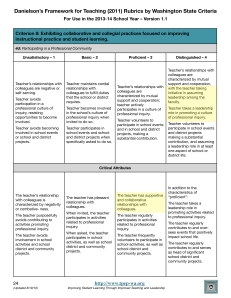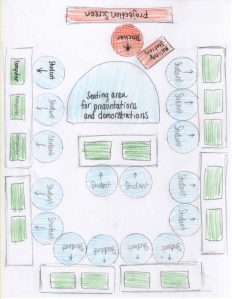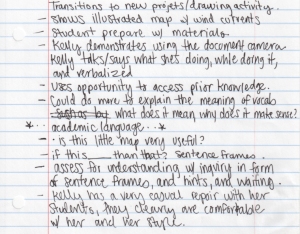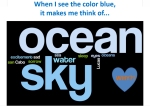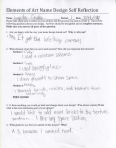E1: Exemplify professionally-informed, growth-centered practice.
The HOPE principle E1 states, exemplify professionally-informed, growth-centered practice. Examples of professional teachers are ones that continually strive to better themselves in a way that benefits students and the school community. Teachers are given many opportunities to accomplish short-term and long-term goals toward improving planning, instruction, and assessment, acquiring new knowledge and skills, collaborating with colleagues, assuming leadership roles, and making upward career advancement. In the Internship Seminar course this spring the topic of professional development and growth was highlighted because this language is part of most teacher evaluations, including the Danielson model, and in the SPU Internship Evaluation which is used as a template to produce a draft professional growth plan.
As the summative assessment for internship, my performance was evaluated across eight criterion which are aligned with Washington Teacher/Principle Evaluation Project (TPEP) expectations for practicing teachers and principals. Piloted in 2010 this project is the driving force behind the state evaluation frameworks which have been adopted by most districts, and include Danielson, Marzano, AWSP, and CEL 5D+. All of the evaluation frameworks assess how teachers are growing their professional practice and participating in their professional community. For teacher-candidates the SPU Internship Evaluation also includes a rubric for professional practice; however it is greatly abbreviated by comparison.
When it came time for the final evaluation conference with my mentor and university coordinator, the most discussion revolved around the language for criterion 8.
As you can see in the image, the rubric states that in order to receive a level 4, the teacher [candidate] is a recognized leader in facilitating the team/group in resolving conflict for effective functioning. Both my mentor and coordinator had a great deal of trouble answering the third prompt which asks what evidence there is to show the goal has been achieved. To help answer this I found it useful to look at the Danielson model “critical attributes” in the related rubric.
In it I found the language to be helpful, the teacher has supportive and collaborative relationships with colleagues, because there could be evidence in emails or other documents which support a teacher’s efforts to support and collaborate with other teachers. After discussing, my mentor, coordinator and I agreed that in order to be a recognized leader for this criterion, a teacher would need to show evidence from multiple sources or have been instrumental in resolving issues collaboratively during the internship period. While I did not achieve a distinguished level of performance under the evaluation criteria, I did gain understanding of its purpose, to use every opportunity to model a high level of cooperative professionalism and positive growth in your teaching practice throughout your career.
As a goal, I will strive to make modeling professionalism and growth-centered practice a repeating refrain in my day-to-day thinking. Finding ways to utilize my strengths and the strengths of others within the learning community by volunteering to participate and lead events or committees will provide me opportunities to grow and learn through cooperative collaboration. At times, teaching can feel like an individual task, especially when having few counterparts as do many art teachers. I think to become a true teacher professional, I will need to recognize that every teacher, administrator, family and friend can be a positive contributor to improving my performance, and ultimately impact student learning.
Complete Danielson’s Framework Rubrics with Critical Attributes


